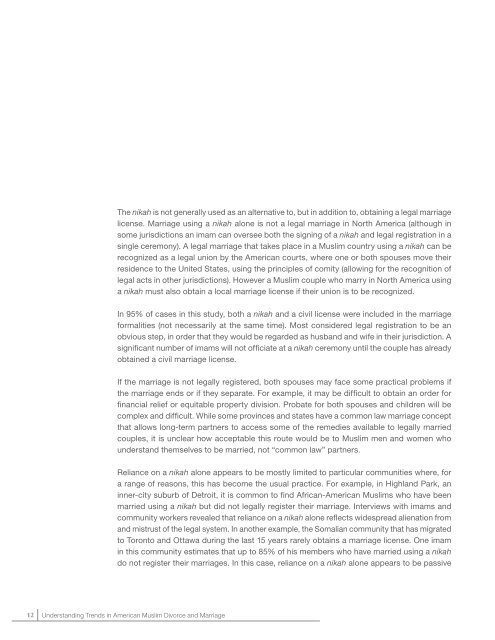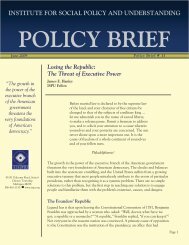Understanding trends in american mUslim divorce and marriage:
Understanding trends in american mUslim divorce and marriage:
Understanding trends in american mUslim divorce and marriage:
Create successful ePaper yourself
Turn your PDF publications into a flip-book with our unique Google optimized e-Paper software.
The nikah is not generally used as an alternative to, but <strong>in</strong> addition to, obta<strong>in</strong><strong>in</strong>g a legal <strong>marriage</strong><br />
license. Marriage us<strong>in</strong>g a nikah alone is not a legal <strong>marriage</strong> <strong>in</strong> North America (although <strong>in</strong><br />
some jurisdictions an imam can oversee both the sign<strong>in</strong>g of a nikah <strong>and</strong> legal registration <strong>in</strong> a<br />
s<strong>in</strong>gle ceremony). A legal <strong>marriage</strong> that takes place <strong>in</strong> a Muslim country us<strong>in</strong>g a nikah can be<br />
recognized as a legal union by the American courts, where one or both spouses move their<br />
residence to the United States, us<strong>in</strong>g the pr<strong>in</strong>ciples of comity (allow<strong>in</strong>g for the recognition of<br />
legal acts <strong>in</strong> other jurisdictions). However a Muslim couple who marry <strong>in</strong> North America us<strong>in</strong>g<br />
a nikah must also obta<strong>in</strong> a local <strong>marriage</strong> license if their union is to be recognized.<br />
In 95% of cases <strong>in</strong> this study, both a nikah <strong>and</strong> a civil license were <strong>in</strong>cluded <strong>in</strong> the <strong>marriage</strong><br />
formalities (not necessarily at the same time). Most considered legal registration to be an<br />
obvious step, <strong>in</strong> order that they would be regarded as husb<strong>and</strong> <strong>and</strong> wife <strong>in</strong> their jurisdiction. A<br />
significant number of imams will not officiate at a nikah ceremony until the couple has already<br />
obta<strong>in</strong>ed a civil <strong>marriage</strong> license.<br />
If the <strong>marriage</strong> is not legally registered, both spouses may face some practical problems if<br />
the <strong>marriage</strong> ends or if they separate. For example, it may be difficult to obta<strong>in</strong> an order for<br />
f<strong>in</strong>ancial relief or equitable property division. Probate for both spouses <strong>and</strong> children will be<br />
complex <strong>and</strong> difficult. While some prov<strong>in</strong>ces <strong>and</strong> states have a common law <strong>marriage</strong> concept<br />
that allows long-term partners to access some of the remedies available to legally married<br />
couples, it is unclear how acceptable this route would be to Muslim men <strong>and</strong> women who<br />
underst<strong>and</strong> themselves to be married, not “common law” partners.<br />
Reliance on a nikah alone appears to be mostly limited to particular communities where, for<br />
a range of reasons, this has become the usual practice. For example, <strong>in</strong> Highl<strong>and</strong> Park, an<br />
<strong>in</strong>ner-city suburb of Detroit, it is common to f<strong>in</strong>d African-American Muslims who have been<br />
married us<strong>in</strong>g a nikah but did not legally register their <strong>marriage</strong>. Interviews with imams <strong>and</strong><br />
community workers revealed that reliance on a nikah alone reflects widespread alienation from<br />
<strong>and</strong> mistrust of the legal system. In another example, the Somalian community that has migrated<br />
to Toronto <strong>and</strong> Ottawa dur<strong>in</strong>g the last 15 years rarely obta<strong>in</strong>s a <strong>marriage</strong> license. One imam<br />
<strong>in</strong> this community estimates that up to 85% of his members who have married us<strong>in</strong>g a nikah<br />
do not register their <strong>marriage</strong>s. In this case, reliance on a nikah alone appears to be passive<br />
12<br />
<strong>Underst<strong>and</strong><strong>in</strong>g</strong> Trends <strong>in</strong> American Muslim Divorce <strong>and</strong> Marriage






